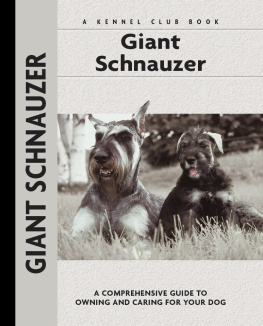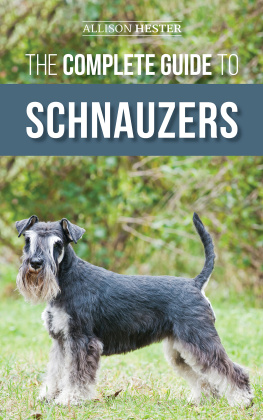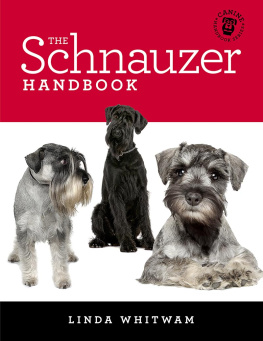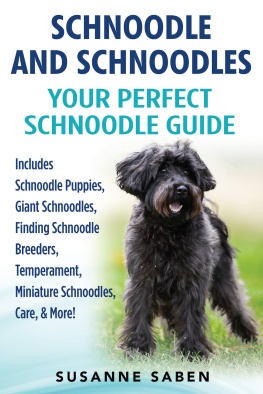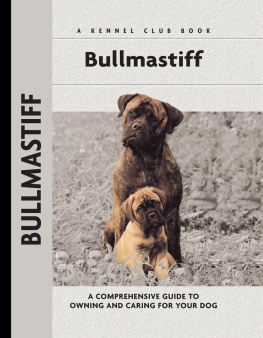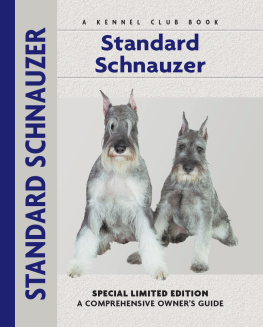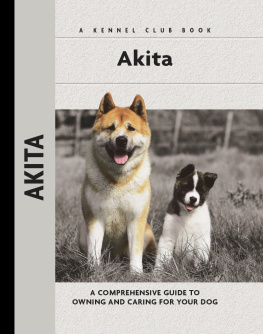Physical Characteristics of the Giant Schnauzer
(from the American Kennel Club breed standard)
Skull: Moderately broad between the ears.
Head: Strong, rectangular in appearance and elongated.
Eyes: Medium size, dark brown and deep-set.
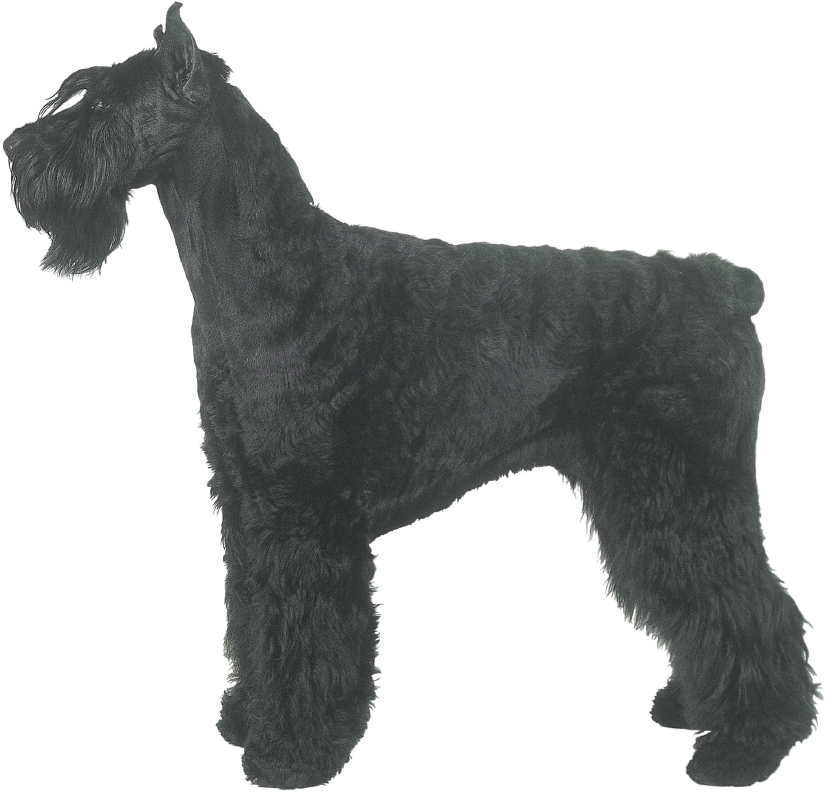
Occiput: Not too prominent.
Ears: When cropped, identical in shape and length with pointed tips.
Neck: Strong and well arched, of moderate length.
Nose: Large, black and full.
Muzzle: Strong and well filled under the eyes.
Lips: Tight and not overlapping, black in color.
Jaws: Powerful and well formed.
Shoulders: The sloping shoulder blades (scapulae) are strongly muscled, yet flat. They are well laid back.
Chest: Medium in width, ribs well sprung but with no tendency toward a barrel chest.
Forequarters: Flat, somewhat sloping shoulders and high withers. Forelegs are straight and verticalwith strong pasterns and good bone. They are separated by a fairly deep brisket. The elbows are set close to the body.
Feet: Well-arched, compact and catlike.
Body: Compact, substantial, short-coupled and strong, with great power and agility.
Back: Short, straight, strong and firm.
Tail: Should be docked to the second or not more than the third joint.
Hindquarters: Strongly muscled, in balance with the forequarters; upper thighs are slanting and well bent at the stifles. The legs from the hock joint to the feet are short. Croup full and slightly rounded.
Color: Solid black or pepper and salt.
Height: At the withers of the male is 25.5 to 27.5 inches, and of the female, 23.5 to 25.5 inches.
Coat: Hard, wiry, very dense; composed of a soft undercoat and a harsh outer coat. Coarse hair on top of head; harsh beard and eyebrows, the Schnauzer hallmark.
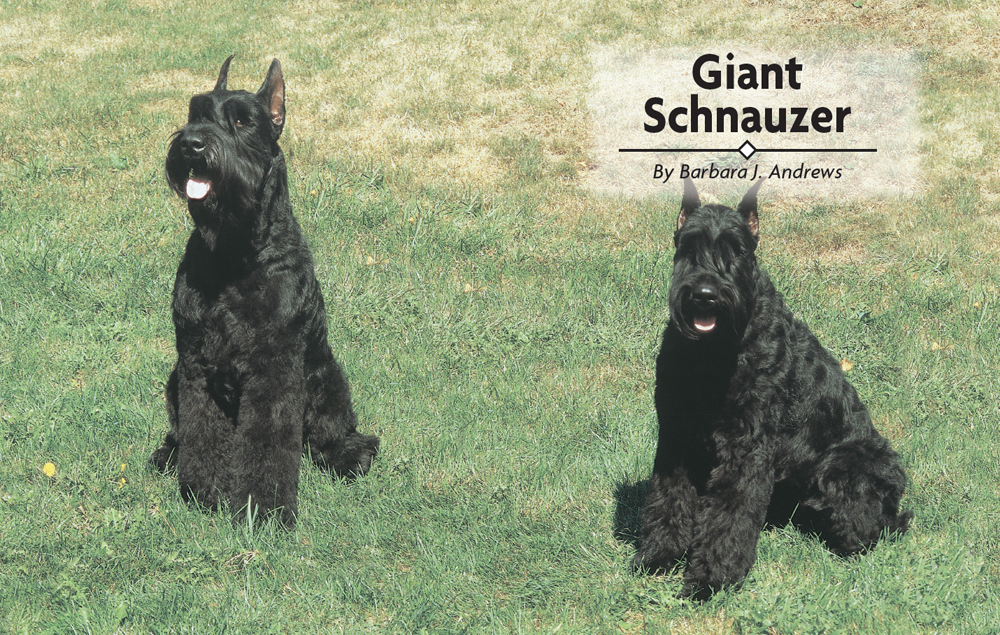
Contents
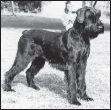
Developed in Bavaria, the largest of the Schnauzers became known as a skilled cattle drover and keen guard dog. Learn how Bavarias secret was discovered as the Giant began to work as a police and protection dog; see how once the secret got out, he skyrocketed to popularity all across Europe and, eventually, around the entire world.
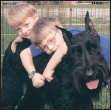
A giant breed is a giant responsibilityare you up to the challenge of owning a Giant Schnauzer? Hes eager, intelligent and trainable, a talented working dog at heart as well as a loyal and lively companion. Learn about the breeds personality and physical characteristics as well as owner suitability and breed-specific health considerations.
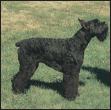
Learn the requirements of a well-bred Giant Schnauzer by studying the description of the breed set forth in the American Kennel Club standard. Both show dogs and pets must possess key characteristics as outlined in the breed standard.
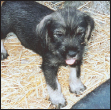
Find out about how to locate a well-bred Giant Schnauzer puppy. Discover which questions to ask the breeder and what to expect when visiting the litter. Prepare for your puppy-accessory shopping spree. Also discussed are home safety, the first trip to the vet, socialization and solving basic puppy problems.
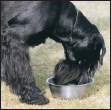
Cover the specifics of taking care of your Giant Schnauzer every day: feeding for the puppy, adult and senior dog; grooming, including coat care, ears, eyes, nails and bathing; and exercise needs for your dog. Also discussed are dog ID and safe travel.
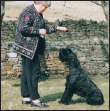
Begin with the basics of training the puppy and adult dog. Learn the principles of house-training the Giant Schnauzer, including the use of crates and basic scent instincts. Get started by introducing the pup to his collar and leash and progress to the basic commands. Find out about obedience classes and other activities.
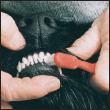
By Lowell Ackerman DVM, DACVD
Become your dogs healthcare advocate and a well-educated canine keeper. Select a skilled and able veterinarian. Discuss pet insurance, vaccinations and infectious diseases, the neuter/spay decision and a sensible, effective plan for parasite control, including fleas, ticks and worms.
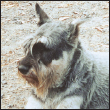
Know when to consider your Giant Schnauzer a senior and what special needs he will have. Learn to recognize the signs of aging in terms of physical and behavioral traits and what your vet can do to optimize your dogs golden years. Consider some advice about saying goodbye to your beloved pet.
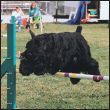
Step into the center ring and find out about the world of showing pure-bred dogs. Heres how to get started in AKC shows, how they are organized and whats required for your dog to become a champion. Also explore some competitive performance events.
K ENNEL C LUB B OOKS G IANT S CHNAUZER
ISBN 13: 978-1-59378-242-9
eISBN 13: 978-1-59378-627-4
Copyright 2005 Kennel Club Books An Imprint of I-5 Press A Division of I-5 Publishing, LLC
3 Burroughs, Irvine, CA 92618 USA
Cover Design Patented: US 6,435,559 B2 Printed in South Korea
All rights reserved. No part of this book may be reproduced in any form, by photostat, scanner, microfilm, xerography or any other means, or incorporated into any information retrieval system, electronic or mechanical, without the written permission of the copyright owner.
10 9 8 7 6 5 4 3 2 1
Photography by:
Paulette Braun, T.J. Calhoun, Alan and Sandy Carey, Sue Cox, David Dalton, Isabelle Franais, Johan & Edith Gallant, Rimma Gurevich, Sylvia Hammarstrom/Skansen Kennel, Carol Ann Johnson, Bill Jonas, Jack and Frances Krall, Alice Roche, Karen Taylor, Michael Trafford and Alice van Kempen.
Illustrations by Rene Low and Patricia Peters.
The publisher would like to thank all of the owners of the dogs featured in this book, including Louise Barbieri, D. Bonow, Sue Cox, Johan & Edith Gallant, Rimma Gurevich, Sylvia Hammarstrom/Skansen Kennel, Dr. Dorothy Izmirlian, Jack & Frances Krall, Eileen Madsen, Lisa Mettler, Judy L. Rodrick and Leesa Stewart.
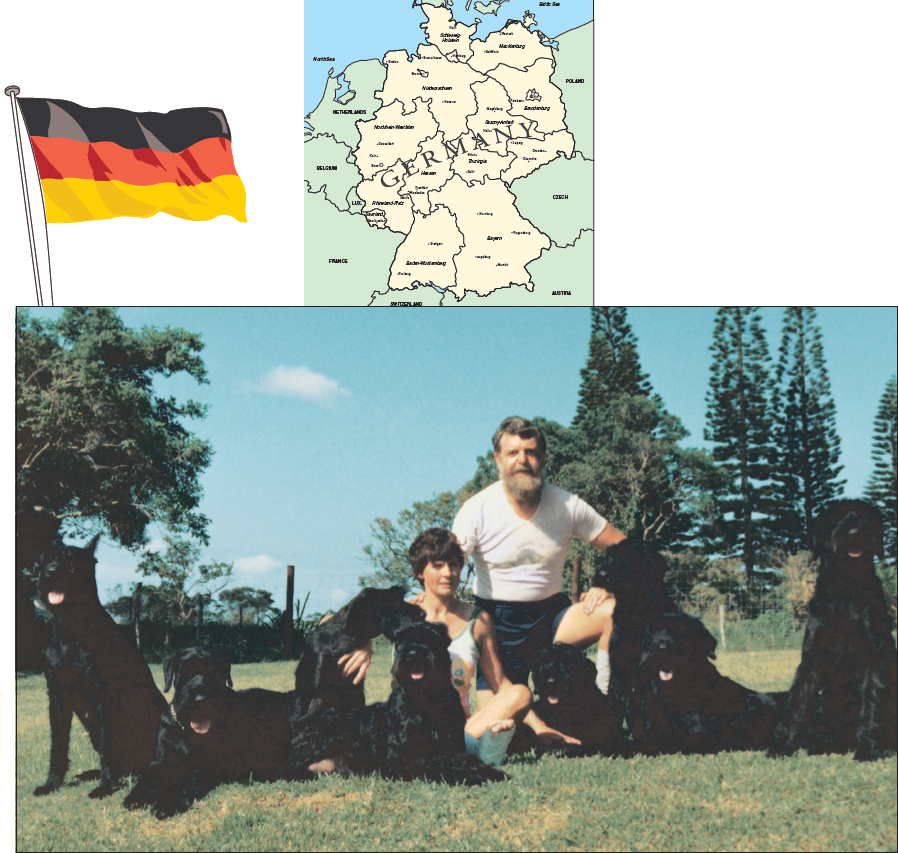
Next page
